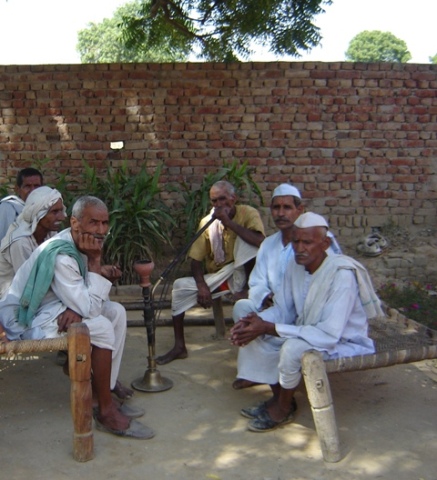Panchayat


Jat Panchayat is the oldest system of local government or the courts in South Asia, and historical mentions date to the c. 250 AD period. These popular courts are first mentioned by Yajnavalkya and then by Narada, Brihaspati, Somadeva and Sukra. These writers covered a period of about a thousand years, c. 250 to 1250 A.D., and they could not have mechanically referred to the popular courts if they were not actually functioning ...[1]
It is found mainly in India, Pakistan, Bangladesh, Sri Lanka, Trinidad and Tobago and Nepal.
Meaning
The word Panchayat means "assembly" (ayat) of five (panch). Traditionally panchayats consisted of wise and respected elders chosen and accepted by the local community. However, there were varying forms of such assemblies. Traditionally, these assemblies settled disputes between individuals and between villages.
The leader of the panchayat was often called the mukhiya or sarpanch, an elected or generally acknowledged position.
Panchayat raj
Mahatma Gandhi advocated panchayat raj as the foundation of India's political system. It would have been a decentralised form of government where each village would be responsible for its own affairs.[2][3] The term for such a vision was Gram Swaraj ("village self-governance"). Instead India developed a highly centralised form of government.[4] However, this has been moderated by the decentralisation of several administrative functions to the local level, empowering elected gram panchayats.[5] There are significant differences between the traditional panchayati raj system, that envisioned by Gandhi, and the system formalised in India in 1992.[6]
Early history
In the time of the Rig Veda (1700 BC), evidences suggest that self-governing village bodies called 'sabhas' existed. With the passage of time, these bodies became panchayats (council of five persons). Panchayats were functional institutions of grassroots governance in almost every village. The Village Panchayat or elected council had large powers, both executive and judicial. Land was distributed by this panchayat which also collected taxes out of the produce and paid the government's share on behalf of the village. Above a number of these village councils there was a larger panchayat or council to supervise and interfere if necessary.[7] Casteism and feudalistic system of governance under Mughal rule in the medieval period slowly eroded the self-government in villages. A new class of feudal chiefs and revenue collectors (zamindars) emerged between the ruler and the people. And, so began the stagnation and decline of self-government in villages.
During the British rule, the autonomy of panchayats gradually declined with the establishment of local civil and criminal courts, revenue and police organizations, the increase in communications, the growth of individualism and the operation of the individual Ryotwari '(landholder-wise) system as against the Mahalwari or village tenure system.
Jat History
Khushwant Singh[8] said it was the Jats who introduced the panchayat system (a body of five elected people that is widely practiced in modern India):
- "They (Jats) brought with them certain institutions, the most important being the pancayat (panchayat), an elected body of five elders, to which they pledged their allegiance. Every Jat village was a small republic".
Hukum Singh Panwar (Pauria)[9] writes :
Some facts about the Jat are, however, indisputable. These are neatly summed up by S. Khushwant Singh, a journalist of repute. "Every Jat Village was a small republic made of people of kindred blood who were as conscious of absolute equality between themselves as they were or their superiority over men of other castes who earned their livelihood as weavers, potters, cobblers and scavengers. The relationship of a Jat village with the State was that of a semi-autonomous Unit paying a fixed sum of money. Few governments tried to assert authority, and those Which did, soon discovered that sending out armed militia against fortified Villages was not very profitable. The Jats' spirit of freedom and equality refused to submit to Brahmanical Hinduism and in its turn drew the censure of the privileged Brahman of the Gangetic plains ... The upper caste Hindus' denigration of the Jat did not in the least lower the Jat in his own eyes". The Jat strongly asserts that "Gold does not change its colour for fear of flames", and "embers are, after all embers even though covered with ash".
Life and culture
The Life and culture of Jats is full of diversity and approaches most closely to that ascribed to the traditional Aryan colonists of India. The Jat lifestyle was designed to foster a martial spirit. When they lost their kingdom, states and social eminence, retired to the country-side controlling and tilling the land with their swords girded round their waists. They would draw the sword out of the scabbard at the command of their panchayat to fight with the invaders. Jats are the best cultivators as well as brave and ready fighters.
See also
References
- ↑ P.B. Udgaonkar, Political Institutions & Administration, Motilal Banarasidass Publishers, 1986, ISBN 978-81-20-82087-6, ...
- ↑ Sisodia, R. S. (1971). "Gandhiji's Vision of Panchayati Raj". Panchayat Aur Insan. 3 (2): 9–10.
- ↑ Sharma, Manohar Lal (1987). Gandhi and Democratic Decentralization in India. New Delhi: Deep and Deep Publications. OCLC 17678104. Hathi Trust copy, search only
- ↑ Hardgrave, Robert L. & Kochanek, Stanley A. (2008). India: Government and Politics in a Developing Nation (seventh ed.). Boston, Massachusetts: Thomson/Wadsworth. p. 157. ISBN 978-0-495-00749-4.
- ↑ Pellissery, S. (2007). "Do Multi-level Governance Meet Local Aspirations?". Asia Pacific Journal of Public Administration. 28 (1): 28–40.
- ↑ Singh, Vijandra (2003). "Chapter 5: Panchayate Raj and Gandhi". Panchayati Raj and Village Development: Volume 3, Perspectives on Panchayati Raj Administration. Studies in public administration. New Delhi: Sarup & Sons.
- ↑ Jawaharlal Nehru, (1964), The Discovery of India, Signet Press, Calcutta, p.288
- ↑ Singh, Khushwant, A History of the Sikhs, Vol. 1, Oxford University Press, Delhi, India, 1977, pp. 14-15.
- ↑ The Jats:Their Origin, Antiquity and Migrations/Prologue,p.xii
Back to Jat Organizations

